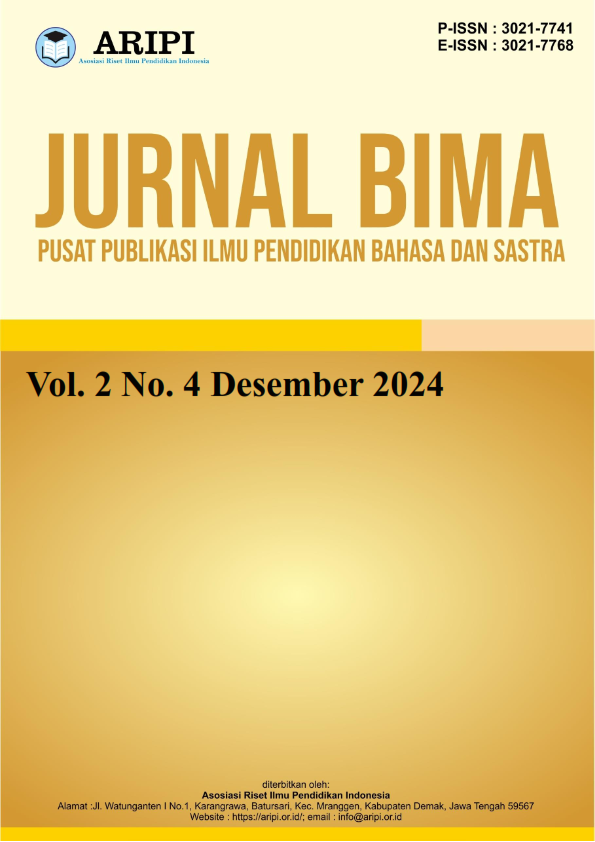Perkembangan Literasi Digital Bahasa Arab : Peluang dan Tantangan Era 5.0
DOI:
https://doi.org/10.61132/bima.v2i4.1380Keywords:
Arabic Language, Digital Literacy, Era 5.0Abstract
This study aims to analyze the role and challenges of the Arabic language in the digital context, particularly in the 5.0 technology era. Using a qualitative approach based on literature review, this research examines technological advancements in Arabic language learning through the analysis of various documents, including journals, books, and related publications. The findings indicate that digital technology has opened up significant opportunities in Arabic language learning, such as online teaching, the digitization of classical literature, and personalized learning using artificial intelligence. However, there are notable challenges, such as the digital divide, limited technological skills among educators, and the complexity of digitizing classical manuscripts. The implications of this study highlight that digital literacy is a crucial element in Arabic language teaching in the modern era. This research also emphasizes the need for digital training for educators and the development of more inclusive technologies to support broader access to Arabic language learning.
Downloads
References
Chaldun, W. (2022). Literasi Digital: Plus dan Minus dalam Pembelajaran Bahasa Arab di Era Milenial. TALENTA Conference Series: Local Wisdom, Social, and Arts, 5(2), 205–208. https://doi.org/10.32734/lwsa.v5i2.1377
Mahmudah. (2020). Penerapan Literasi Digital Dalam Pembelajaran Bahasa Arab di Madrasah Ibtidaiyah Negeri 9 Banjar. Journal Tarbawi Stit Darul Hijrah, 10, 1–8.
Muis, M. (2020). Bahasa Arab Di Era Digital: Eksistensi Dan Implikasi Terhadap Penguatan Ekonomi Keumatan. Al-Fathin: Jurnal Bahasa Dan Sastra Arab, 3(01), 60. https://doi.org/10.32332/al-fathin.v3i01.2319
Mustaufiy, A. S. H. (2023). Peluang dan Tantangan Pengembangan Literasi Digital Dalam Pembelajaran Bahasa Arab Pada Jenjang Pendidikan Dasar. FASHLUNA, 1(1), 87. http://scioteca.caf.com/bitstream/handle/123456789/1091/RED2017-Eng8ene.pdf?sequence=12&isAllowed=y%0Ahttp://dx.doi.org/10.1016/j.regsciurbeco.2008.06.005%0Ahttps://www.researchgate.net/publication/305320484_SISTEM_PEMBETUNGAN_TERPUSAT_STRATEGI_MELESTARI
Nurcholis, A., Hidayatullah, S. I., & Rudisunhaji, M. A. (2019). Karakteristik Dan Fungsi Qira’ah Dalam Era Literasi Digital. El-Tsaqafah : Jurnal Jurusan PBA, 18(2), 131–146. https://doi.org/10.20414/tsaqafah.v18i2.1853
Rahmawati, R. A. (2023). Implementasi Literasi Digital Pada Pembelajaran Maharah Qira’ah Al-Mutawassithah. An Naba: Jurnal Pemikiran Dan Penelitian Pendidikan Islam, 13(1), 78–92.
Rohman, A. D. (2022). Efektivitas Metode Pembelajaran Berbasis STEAM Terhadap Peningkatan Keterampilan Siswa MI/SD di Era Abad 21. 03(01), 48–58.
Syagif, A. (2023). Paradigma Pembelajaran Bahasa Arab Di Era Society 5.0. FiTUA: Jurnal Studi Islam, 3(2), 134–144. https://doi.org/10.47625/fitua.v3i2.407
Downloads
Published
How to Cite
Issue
Section
License
Copyright (c) 2024 Jurnal Bima : Pusat Publikasi Ilmu Pendidikan bahasa dan Sastra

This work is licensed under a Creative Commons Attribution-ShareAlike 4.0 International License.






